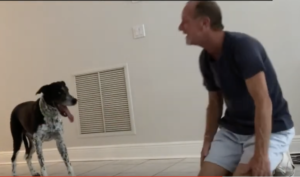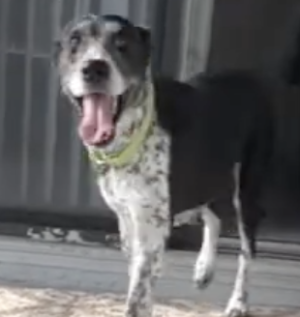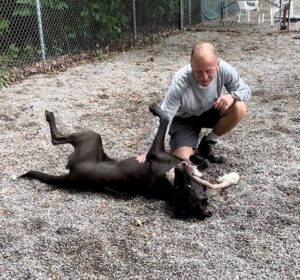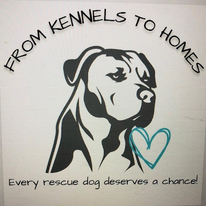What does Heal the Dog Look Like in Reality?
An interview with Canine Behaviorist & Trainer, Thommy Harley
Our interview with Canine Behaviorist, Trainer & Founder of the nonprofit, From Kennels to Homes, continues:
Methods of Training, Healing the Dog, Part II
Can you help us all understand what IS force-free or fear-free, as opposed to other sorts of training out there? Why can shelter trainers not do what you do?

Differentiating myself, again, is having a complete understanding of dog behavior, rather than many trainers, who want to do obedience and correction methods – if a dog is pulling on the leash, they will correct them. It doesn’t teach the dog any other way to react, it just corrects them at that moment. Holistically, for their lives. It doesn’t give them another choice.
There are three main methods of training –
- Force-free Positive/Fear-free – Is exactly what it sounds like. We are working with the dog to help them make another choice; we will not punish or hurt them if they don’t do what we want.
- Punishment – This is a long-standing one. What it basically revolves around is dominance theory, which is decades-old. It says that We need to be the alpha and the boss of that dog – and the dog needs to do what we want them to do, no questions asked. These are the trainers that will use punishment methods – shock, choke and prong collars – they train by making the dog so fearful, that they are going to do what they are asked. This has been debunked by science over and over again. This is, in my opinion, lazy trainers who don’t want to understand the behavior, but just want to correct it. If people read the science, most of your large animal advocate organizations preach against these methods because they do hurt the dog – and they do hurt the dog – people can say a prong collar does not hurt – it does hurt – choke collars choke the windpipe – it does hurt — you’re instilling fear in a dog instead of trust. The dogs end up doing what they’re asked to do because they don’t want to be hurt. This is something I’ve wanted to have outlawed because you’re just hurting dogs who are looking to us for help.
- Balanced – It’s a powder puff phrase. The trainer is going to do whatever they need to do to get the dog to do what they want. They can be positive and force-free, but they will also use punishment. If being positive and force-free doesn’t get the response they want, they will certainly put a shock collar on and get the response. Most trainers are not upfront about the methods they use. People misunderstand, Oh, but it’s balanced — You don’t need balanced. You don’t need anything to do with punishment methods.
When you say, you help heal the dog, can you explain what that is? Does this have lasting effects on the behavior of the dog? Why is this different than the more popular methods of correcting the dog and addressing his or her behavior?


I call it Healing the Dog because whatever they have been through, they probably have a distrust of humans motivated by 100% fear. As you would help a child with fears, you wouldn’t just correct them if they’re afraid of a spider, you would help them work through their fear, which is what needs to be done with dogs.
If you take a dog who’s been abused – and they pull on the leash and you correct them by jerking the leash – you’re not healing them, you’re just perpetuating the abuse they’ve already experienced. It’s hugely important; the cases I work with – aggressive behavior, feral dogs, abused, neglected – the number one thing with these dogs is that they do not trust humans. We’ve got to heal them.

The first thing we do is heal them by letting them know that they are safe, we’re here to help them, and they will not be hurt. I don’t go in there right away and try to cure these dogs – I need a foundation of trust with them first. Once they trust me, I can help them, because they know I will not hurt them. My work with dogs is a PARTNERSHIP, between myself and them.
I think that’s another big difference of the way I work is that I start a foundation of building a bond – to me, working with dogs is a partnership; me helping them and they help me – it’s a critical point – it’s not me being the trainer to do what I want, we work as partners, holistically for the rest of their life, it’s so much more beneficial. They overcome whatever issue they have as they gain trust and have less fear.
How long does it take, in general, for you to heal a dog? Is it dependent upon circumstances, such as abuse, confinement, lack of socialization from original home, kennel stress, adolescent aggression, or even genetically-based?
Healing a dog is based on a number of factors; it is certainly not an extremely long process, as most would expect. Depending on the issue and the amount of time I spend with a dog – if I have a dog who has issues and I only work with them once a week, it’s going to take a lot longer.
If I take them and work with them constantly for a week, it’s going to speed up a lot quicker for them. I go at the dog’s pace; when we get a good enough trust bond, I do have to push them a little, compassionately, to try a little more progress.
Feral Dogs. For instance, a feral dog – they’ve never been around humans or a leash – they take a little while to bond. I need them to trust me. Many times, they will snap at the leash and they will growl. Then, we start the process of moving them along. The first day we may just take three steps – that’s good – over time, we increase the steps. When I think there’s an issue of needing to push a dog further – You need to come out of the front yard – I will push them a little further with that.
But if we take an approach to dogs as healing, not correcting, that’s when we look at the dog as a real live being who we can help. You have to have that compassion. My goal going into every dog is to help them. As a byproduct, it helps the client/owner. But I want to help that dog. I don’t want them to be fearful and feeling as though they live in a scary world. I want to give them the tools of confidence and trust to help them be happier, more comfortable and less stressed.
Can you tell me about some special dogs with whom you’ve been particularly challenged? Tell me their stories.
There are so many special dogs who’ve overcome their issues; they’ve trusted me to help them. There are a few issues that are the most challenging – feral, dog aggression, and fear-based because they’ve been hit or abused.
Zane is a good example – He came into Miami Dade Animal Services with 2 other siblings. They were all feral. I don’t know how they actually caught them; nobody would go near them. They would avoid eye contact; they just shut down emotionally. Shaking. With all 3 of those dogs, I had to go in there and be able to leash them and be able to pull them out of the kennel. It was frightening for them. My goal for them was to become happier & more comfortable dogs. I knew that once we got them out of the kennel, we could go down the hallway and out of doors. They could see that it’s a beautiful world for a dog.
We just kept working on that, and Zane has become an amazing dog. He loves people – and other dogs – a year later, he still has a little stranger danger, to be expected – he sits back and barks, letting us know. Feral dogs are one of my passions because they are so shut down emotionally, they just want to curl up in a ball and die from fear.
Dog Aggression. Dog aggression is a common thing – I’ve worked and rehabbed quite a few former fighting dogs – the number one thing to understand with dogs is that they dislike any kind of conflict. There’s no joy in fighting or biting. They are such peaceful creatures that we push them into a situation that they exhibit what people call aggression – but I don’t agree with that – out of a survival instinct.
There’s been quite a few of these dogs who I’ve been able to work with. It’s a slow method; we walk with a dog. Then, we see other dogs…
